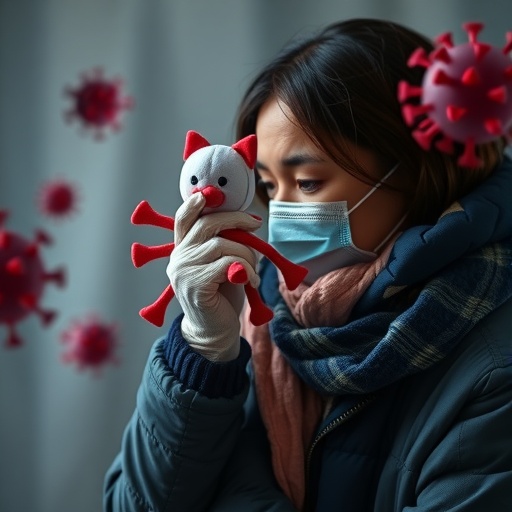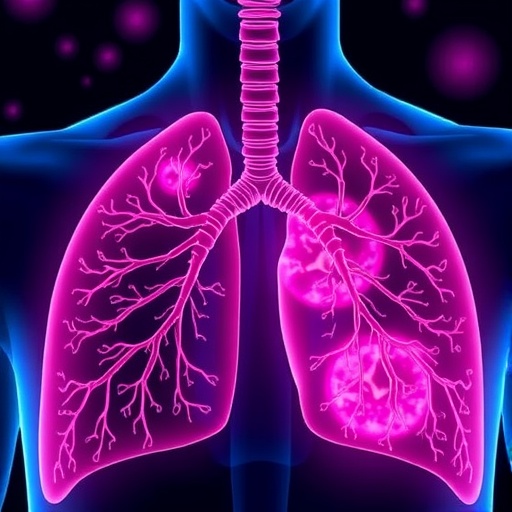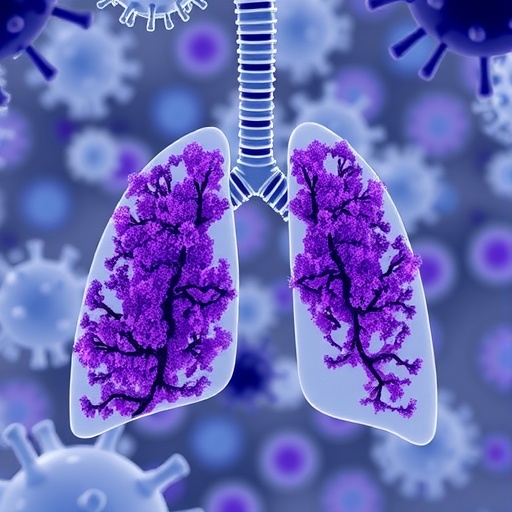A groundbreaking study conducted by researchers at National Jewish Health has uncovered a fascinating phenomenon: recent infection with the common cold, primarily caused by rhinoviruses, may confer temporary protection against SARS-CoV-2, the virus responsible for COVID-19. This discovery adds a critical piece to the complex puzzle surrounding why children exhibit fewer and less severe symptoms of COVID-19 compared to adults. The findings hold promising implications for future interventions targeting respiratory viral infections.
The research, published on August 11, 2025, in the esteemed Journal of Infectious Diseases, utilized data from the Human Epidemiology and Response to SARS-CoV-2 (HEROS) study. This extensive nationwide study tracked over 4,100 individuals across 1,394 households from May 2020 to February 2021. By analyzing thousands of self-collected nasal swabs, investigators detected the presence of SARS-CoV-2 alongside common respiratory viruses, especially rhinoviruses, allowing for a comprehensive examination of viral interactions within the human airway.
What emerged was a statistically significant reduction in SARS-CoV-2 infections among individuals, particularly children, who had recently contracted rhinovirus infections. Scientists propose that this protective effect stems from an antiviral state induced by the initial rhinovirus infection. Rhinoviruses are known to stimulate a robust interferon response—part of the innate immune system—in the respiratory tract. This surge in interferon and related signaling molecules effectively “primes” the immune system, enhancing its readiness to combat subsequent viral invaders such as SARS-CoV-2.
Dr. Max Seibold, PhD, the senior author and director of the Regenerative Medicine and Genome Editing Program at National Jewish Health, explained that the data underscores how the immune boost triggered by a recent cold infection grants the body an early advantage in suppressing SARS-CoV-2 before the virus gains a foothold. Notably, children, who tend to experience higher frequencies of common colds, demonstrate elevated baseline expression of interferon-related genes compared to adults, which may contribute to their relative resilience against COVID-19.
The phenomenon observed fits within the broader concept of heterologous viral interference, whereby infection with one virus modulates the host’s response to a subsequent viral challenge. This mechanism has been documented with various respiratory viruses but had not previously been prospectively demonstrated in relation to SARS-CoV-2. The study’s longitudinal design, involving repeated viral testing and gene expression profiling, represents an important methodological strength that bolsters the credibility of the findings.
By dissecting airway gene expression profiles, the research team found that children inherently express higher levels of interferon-stimulated genes, which form a crucial frontline defense against viral pathogens. The enhanced expression of these genes likely establishes a heightened antiviral state, restricting SARS-CoV-2 replication during the critical early stages of infection and thereby reducing both infection rates and disease severity.
Despite these encouraging insights, the researchers caution against deliberate exposure to cold viruses as a preventive strategy. Dr. Camille Moore, PhD, lead author of the study, emphasized that the goal is to understand the underlying immunological mechanisms that govern viral interactions to inform safer and more effective prevention methods. This knowledge could lead to innovative approaches, such as therapeutics that mimic the protective interferon response without subjecting individuals to the risks of actual infections.
This study also builds upon previous observations from the HEROS investigation, which reported that children are six times less likely than adults to develop symptomatic COVID-19. The current data offer a compelling explanation rooted in natural viral interference combined with age-related immune system differences, highlighting a layered and dynamic immune landscape shaped by both development and recent exposures.
The collaborative effort involved research partners from 12 different U.S. cities, enhancing the diversity and representativeness of the study cohort. Such breadth ensures that the findings are broadly applicable across various demographic groups and geographic settings, lending further weight to their significance in public health considerations.
In sum, the research elucidates how prior respiratory infections may transiently fortify mucosal and systemic antiviral defenses, effectively serving as a temporary shield against SARS-CoV-2. It prompts a reevaluation of how sequential viral infections interact within hosts and encourages the exploration of immunomodulatory treatments inspired by natural viral dynamics.
National Jewish Health continues to lead the frontiers of respiratory medicine, offering specialized expertise in diagnosing and treating complex respiratory, cardiac, and immune disorders. Their dedication to pioneering research and comprehensive patient care positions them uniquely to translate these findings into clinical practice, potentially transforming the management of respiratory viral illnesses.
This discovery not only enriches scientific understanding of viral interference but may also spur innovative research aimed at exploiting the body’s innate immune machinery to mitigate current and future pandemics. As we deepen our comprehension of the interplay between common respiratory viruses and emergent pathogens like SARS-CoV-2, new strategies for prevention and treatment become increasingly attainable.
—
Subject of Research: Viral interactions and immune responses influencing SARS-CoV-2 susceptibility
Article Title: The Common Cold Is Associated With Protection From SARS-CoV-2 Infections
News Publication Date: August 25, 2025
Web References:
https://academic.oup.com/jid/advance-article/doi/10.1093/infdis/jiaf374/8230147?login=true
http://dx.doi.org/10.1093/infdis/jiaf374
Keywords: Viral infections, SARS-CoV-2, rhinovirus, interferon response, heterologous viral interference, immune system, respiratory viruses
Tags: common cold and COVID-19 protectionCOVID-19 severity in childrenHEROS study on COVID-19immune response to respiratory virusesimplications of rhinovirus infectioninterferon response to rhinovirusJournal of Infectious Diseases research findingsnasal swabs and viral detectionNational Jewish Health COVID studyrespiratory viral infections in childrenrhinovirus and SARS-CoV-2 interactiontemporary immunity from common cold





